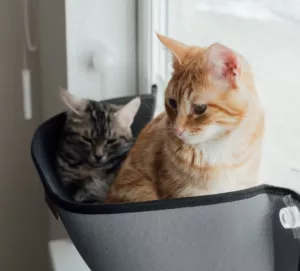Are you puzzled about which cat litter to choose for your new kitten? Don’t worry, you’re not alone.
Explore the perfect cat litter for your kitten to ensure a clean, odor-free environment. The first place to look for comprehensive information on the top 5 cat litters for kittens is this article.
We’ll talk about different kinds of litter, safety issues, transitional advice, and more. Intrigued? Let’s start now.
The best 5 cat litters for kittens are briefly described in this table, along with their benefits and drawbacks.
| Cat Litter Brand and Type | Pros and Cons |
|---|---|
| World’s Best Cat Litter: Corn-Based |
Pros: Biodegradable, flushable, low dust. Cons: May be a bit expensive. |
| Blue Buffalo Naturally Fresh: Walnut-Based | Pros: Excellent odor control, eco-friendly. Cons: Dark color makes it hard to spot waste. |
| Dr. Elsey’s Kitten Attract Litter: Clay-Based | Pros: Specially formulated for kittens, easy to scoop. Cons: Not biodegradable. |
| Purina Yesterday’s News: Recycled Paper | Pros: Low tracking, good for sensitive paws. Cons: Less effective odor control. |
| Feline Pine Original Litter: Pine Wood | Pros: Natural scent, biodegradable. Cons: Some kittens may not like the wood texture. |
Types of Cat Litter: A Comprehensive Overview
Clumping Clay Litter:
This is the most common and not unusual type of cat litter and is extensively used for its comfort. It forms clumps when wet, making it smooth to scoop. But it may be dusty, which may also cause respiratory troubles for some cats.
Non-Clumping Clay Litter:
Non-Clumping Clay Litter absorbs urine, but it doesn’t form clumps. While it’s usually less luxurious, it can be more difficult to keep the clutter field clean. Frequent changing is frequently required.
Silica Cat Litter:
Composed of tiny silica gel beads, this litter is notably absorbent and terrific for controlling odors. It is a chunk on the pricey side but lasts longer, which could offset the initial cost.
Natural Cat Litter:
Natural cat litter is crafted from eco-friendly substances like corn, wheat, or recycled paper. It is a superb choice for environmentally conscious pet proprietors but can be expensive than other kinds.
Table: Types of Cat Litter
| Type | Pros | Cons |
|---|---|---|
| Clumping Clay | Easy to scoop | Can be dusty |
| Non-Clumping Clay | Inexpensive | Harder to clean |
| Silica Gel | Odor control | Expensive |
| Biodegradable | Eco-friendly | May not clump well |
Best litter for Kittens?
Kittens are clearly curious and may attempt to eat the clutter. For kittens under three months, experts often recommend non-clumping clay or biodegradable litters.. These types are normally safer if ingested in small amounts.
Changing Cat Litter
Switching your kitten to a new kind of clutter? It is vital to make the transition slow to avoid upsetting your kitten’s habits. Start by blending a small quantity of the new muddle with the old, and step by step, increase the new type over a week.
How do you keep a litter box from smelling?
Nobody desires a smelly muddle box of their own. Regular scooping and frequent litter replacement are key to keeping a cat litter box odor-free.
Silica gel and clumping clay litters are typically pleasant alternatives for controlling smell. However, keep in mind that regular scooping is key to keeping any litter box fresh and clean.
Cost Factor: What’s Your Budget?
The price of cat clutter can range broadly. Clumping clay is usually a mid-variety option, while silica gel can be more expensive. It is essential to factor in not just the upfront price but also how often you’ll need to update the clutter.
Environmental Concerns: Think Green
If you’re seeking to make an eco-friendly choice, biodegradable litters are your excellent wager. These items break down easily. Additionally, they often come from renewable sources. Therefore, they benefit both you and the planet.
Conclusion
Selecting the right litter to your kitten does not need to be a daunting project. By using considering elements like your kitten’s age, your smell control preferences, and your price range, you could make an informed choice. Are you ready to find the perfect match for your new feline friend?


